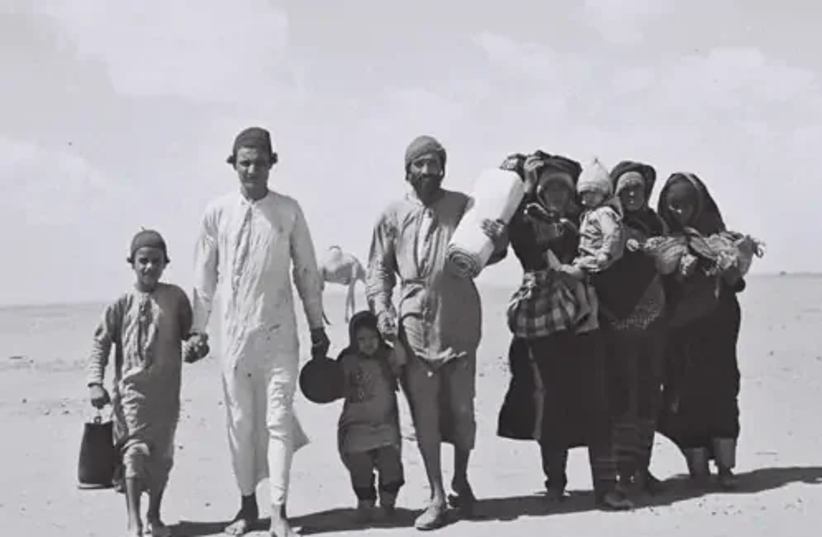It has been said that “A people without the knowledge of their past history, origin and culture is like a tree without roots.”
The Jewish People have a very good reputation for memory and remembrance. Our annual ancient festivals revolve around past events and our recounting of them, and our modern days of commemoration speak to events that shaped the Jewish people over the last century.
Other festivals have gained popularity in recent years, like the Sigd, which is thankfully growing in prominence far beyond the Ethiopian community.
However, there is a date that speaks to the largest Jewish community in Israel – and sadly remains all but unknown.
With the help of this author, then-Knesset member Shimon Ohayon passed a law in 2014 designating November 30 as the Day of Commemoration for the Jewish Refugees From Arab Countries and Iran.

Nevertheless, eight years later, according to a survey commissioned earlier in the year by Iraqi-British Jewish businessman and philanthropist David A. Dangoor CBE, only 11% of the young Israelis polled had heard of it.
This, despite the fact that the law envisioned that this day would be a national day of remembrance and that the education system would spend the day learning about the history and culture of the Jews from the Middle East and North Africa (MENA).
It is clear that the law has yet to change the situation in the Israeli national education system, which appears almost completely devoid of any studies involving these communities.
The facts were borne out by the same survey of those who had recently finished their formal education.
While 74% of all respondents claimed that the history, heritage and culture of Ashkenazi Jewry is taught in the educational system to a large or somewhat large extent, only 14% could say the same about Mizrahi Jewry.
By way of example, while only 7% of respondents could identify the Farhud, an Iraqi pogrom in which hundreds of Jews were slaughtered in 1941, some 58% could correctly identify Kristallnacht, the pogrom in Nazi Germany in 1938.
What makes this even more remarkable is that this is the history and culture of a community which represents around 53% of all Israeli Jews.
This means that the majority of Israeli Jews are growing up rootless.
They do not know their own history. They might learn in their family homes about their culture and tradition, but even this is diminishing with every generation.
This is not just a shame; it is dangerous for our national narrative and identity.
What does Israel look like from the outside?
MOST PEOPLE in the West see Israel as merely an extension of how they perceive the Jewish community around them – which, despite the US, the UK and others beginning as Sephardi communities, today are overwhelmingly Ashkenazi.
So, when many people think of Israel, they see it as a purely European endeavor, populated by Europeans who have tried to impart a white colonialist attitude towards a region foreign to them.
A softer or stronger variant of this is believed by friend or foe of Israel alike, and the majority of those in between.
Of course, none of this is true.
The Jewish people are indigenous to this region regardless of which exile their ancestors endured. Our civilization, culture, language and identity were all formed in the Land of Israel.
However, without teaching about the part of the Jewish people who never left the region, whose language and culture are far more ancient than many if not most other Middle Eastern identities today, the outsider’s narrative will continue to endure.
This can all be dispelled with simple facts about the Jews of the Middle East and North Africa. How many people know that the oldest Jewish Diaspora in history was in Iraq? That there was a Jewish kingdom in Yemen? That Jews lived in Arabia speaking Arabic and Hebrew centuries before Islam began?
Or that the Jews of the region had a physical, ongoing and never-severed relationship with the Land of Israel?
It is extremely difficult to find a famous historic Jewish figure from the MENA region who did not spend some time in one of the Jewish communities that held on in the Jewish homeland throughout the millennia. Understanding these facts and these ties gives us stronger roots, necessary especially since we are under constant and savage attack.
Israel and the Jewish world’s education systems have to add the history of the Jews of the Middle East and North Africa to their curriculum. There are immense gaps without them.
To face the immense challenges of the present and the future, we need the strongest roots. The roots of identity, history and culture of all Jews are essential to our national narrative, to give the fullest picture possible to all.
This should be obvious, and it needs to change.
We need to start telling ourselves and others the complete story of our people.
The writer is a former senior Israeli government adviser, an international communications strategist, and the CEO and co-founder of The Heritage Center for Middle East and North Africa Jewry.
